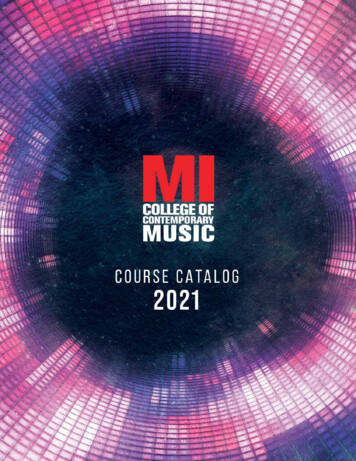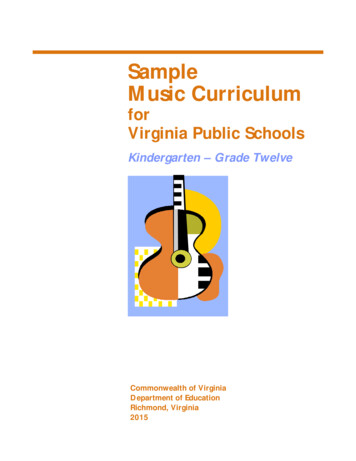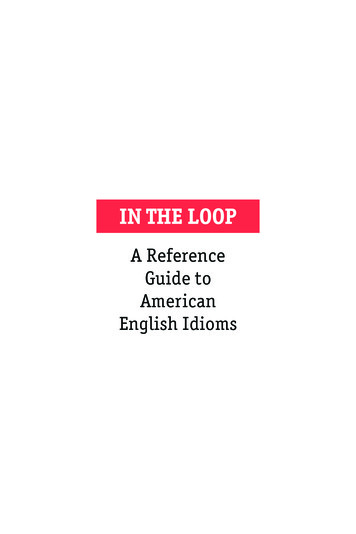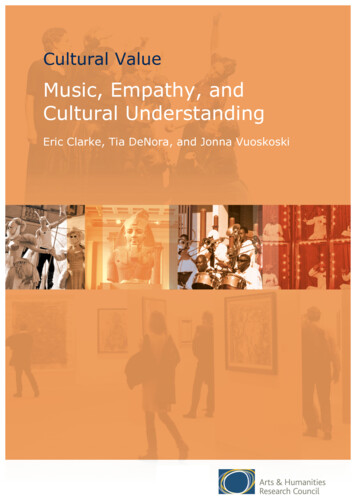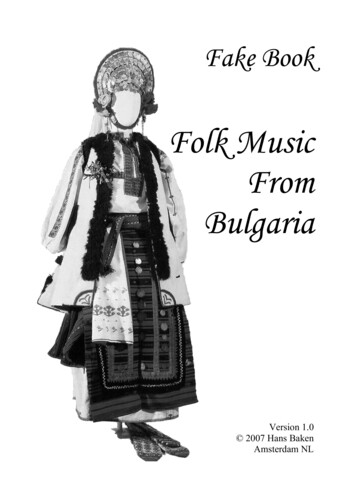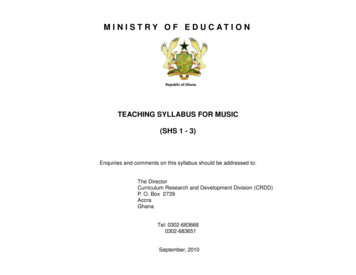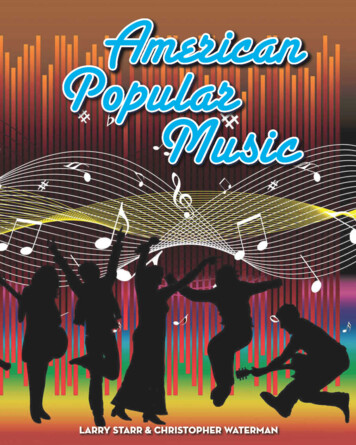
Transcription
AmericanPopularMusicLarry Starr & Christopher Waterman
Copyright 2003, 2007 byOxford University Press, Inc.This condensation of AMERICANPOPULAR MUSIC: FROMMINSTRELSY TO MP3 is acondensation of the bookoriginally published in Englishin 2006 and is offered in thiscondensation by arrangementwith Oxford University Press, Inc.Larry Starr is Professor of Musicat the University of Washington.His previous publications includeThe Dickinson Songs of AaronCopland (2002), A Union ofDiversities: Style in the Music ofCharles Ives (1992), and articlesin American Music, Perspectivesof New Music, Musical Quarterly,and Journal of Popular MusicStudies. Christopher Watermanis Dean of the School of Arts andArchitecture at the Universityof California, Los Angeles. Hisprevious publications include Jùjú:A Social History and Ethnographyof an African Popular Music (1990)and articles in Ethnomusicologyand Music Educator’s Journal.Clockwise from top:Bob Dylan and JoanBaez on the road;Diana Ross sings tothousands; LouisArmstrong and histrumpet; DJ Jazzy Jeffspins records; ‘NSyncin concert; ElvisPresley sings and acts.
AmericanPopularMusicLarry Starr & Christopher Waterman
C O N T E N T S Introduction. 3CHAPTER 1: Streams of Tradition: The Sources of Popular Music.6CHAPTER 2: Popular Music: Nineteenth and Early Twentieth Centuries . 12An Early Pop Songwriter: Stephen Foster . 19CHAPTER 3: Popular Jazz and Swing: America’s Original Art Form. 20CHAPTER 4: Tin Pan Alley: Creating “Musical Standards” . 26CHAPTER 5: Early Music of the American South: “Race Records” and“Hillbilly Music” . 30CHAPTER 6: Rhythm & Blues: From Jump Blues to Doo-Wop . 34Big Mama Thornton . 39James Brown and Aretha Franklin. 40Jazz Gallery . 44CHAPTER 7: Country Music: Songs of Tradition and Change . 56Hank Williams . 61CHAPTER 8: Rock ’n’ roll : A Generation’s Identity . 62Bob Dylan . 70CHAPTER 9: Music: The Business . 72Bill Haley and “Rock Around the Clock” . 65CHAPTER 10: Music Technology: Innovations and Controversies . 76The Electric Guitar. 80CHAPTER 11: Hip-Hop: The “Rapper’s Delight” . 82Prince . 88The Message . 89CHAPTER 12: World Music Collaborations: Crossing Cultural Boundaries . 90Glossary . 94
IntroductionPopular music, like so muchof American culture, reflectsa kaleidoscope of contribu tions, a cross-fertilization of styles,and a blending of dreams. It couldhardly be otherwise in this nationof immigrants. Arguably the UnitedStates is a perfect musical laborato ry: take people from every corner ofthe globe, give them freedom to cre ate. Distribute their effort: by sheetmusic, phonograph, radio — or, forthe younger reader: by Blu-ray Disc,mp3, Internet stream.And what results! Europeanballads recast with African poly rhythmic textures or blended witha Cuban-flavored habanera (bold faced terms are defined in the glos sary) or a more “refined” rumba.“Cold” bop. “Hot” jazz. “Acid” rock.“Gangsta” rap. We might speak lessof a singular American popular mu sic than of a constellation of mutu ally-enriching American popular“musics.” Elvis Presley borrows fromAfrican-American blues, and blackMotown stars recast “white” pop.Ask Khmer-American rapper PrachLy, also known as “praCh,” aboutAmerican popular music and he’llspeak of growing up with SnoopDog, Dr. Dre, Run DMC, and PublicEnemy on the radio and of cuttinghis first album in his parents’ garage.Lacking a mixing board, Prach useda karaoke machine and sampled oldKhmer Rouge propaganda speechesfor his powerful musical condemna tion of the Cambodian genocide.We hope the pages that followconvey a sense of creative ferment,of artistic drive, and of how Ameri cans, borrowing from diverse musi cal traditions, have made their ownoriginal contributions to humanity’struly universal language. The readerwill encounter here crooners andrappers, folkies and rockers, the“King,” a Prince, and the “Queen ofSoul.” Explained here is the latest inmusical technology, from the solidbody electric guitar to the losslesscompression digital file. And read ers will learn about the people whomake the music, truly American intheir stunning diversity. Theirs areperhaps the most wonderful storiesof all.Musicians gather around the great Louis Armstrong, seated at the piano.Armstrong grew up in New Orleans in the early part of the 20th century andgave the world a lasting legacy — jazz.3
Louis Armstrong in a 1931 photoConsider the African-Americanchild, born in 1901 and living in apoor New Orleans neighborhood.At the age of seven, with his motherand sister in poverty, he found workwith a family of junk dealers — Rus sian Jewish immigrants nearly aspoor as his own family. “They werealways warm and kind to me,” helater would write — indeed, as onescholar later put it, they “virtuallyadopted him.” The boy would ridethe junk wagon and blow a small tinhorn to attract potential customers.4As he later wrote:One day when I was on the wagonwith Morris Karnovsky wepassed a pawn shop which hadin its window — an old tarnishedbeat up “B” Flat cornet. It costonly 5. Morris advanced me 2on my salary. Then I put aside 50cents each week from my smallpay — finally the cornet was paidin full. Boy, was I a happy kid.That boy’s name was Louis Arm strong. He would give the world jazz.American popular music is thesound of countless Louis Arm strongs sharing the music in theirsouls. It spans a matchless range ofhuman experience, from mattersof the heart — Sinatra bemoaninga lost love “in the wee small hoursof the morning” — to the politicalprotest of Country Joe and the Fishperforming the “I Feel Like I’m Fixin’to Die Rag.” Some tunes propelcouples to the dance floor, there to
twist or jitterbug, hustle or tango.Songwriters depict their muses sovividly we can almost believe themreal: the Beach Boys’ Caroline per haps, Chuck Berry’s Maybellene,Bob Dylan’s “Absolutely Sweet Ma rie,” or Rickie Lee Jones’s “Chuck E.”And sometimes what resonates isnot the girl in the song, but the onewith whom you first heard it, a longtime ago.“Without music, life would be amistake,” the German philosopherFriedrich Nietzsche wrote. Hereyou will meet many visionaries whowould agree.—Michael Jay FriedmanClockwise from upper left: A couple whirls across the dance floor of Harlem’s Savoy Ballroom, 1953; Dancers “Twist” at New York’s Peppermint Lounge, 1961; Crooner Frank Sinatra, 1943; Singer-songwriter Rickie Lee Jones, 1999; Country Joe McDonald in the late 1990s. 5
CHAPTER 1 Streams of Tradition:THE SOURCES OFPOPULAR MUSICEvery aspect of popularmusic today regarded asAmerican has sprungfrom imported traditions.These source traditionsmay be classified into threebroad “streams”: EuropeanAmerican music, AfricanAmerican music, and LatinAmerican music. Each ofthese is made up of manystyles of music, and eachhas profoundly influencedthe others.6The European-American StreamUntil the middle of the19th century, Americanpopular music was almostentirely European in character. Thecultural and linguistic dominance ofthe English meant that their musicestablished early on a kind of “main stream” around which other stylescirculated.At the time of the AmericanRevolution, professional composersof popular songs in England drewheavily upon ballads. Originally anoral tradition, ballads were circu lated on large sheets of paper calledbroadsides. While some broadsideballads were drawn from folk tra dition, many were urban in originand concerned with current events.In most cases only the words wereprovided, with an indication of a tra ditional melody to which they wereto be sung. Balladmongers hawkingthe broadsides sang them on thestreets. Composers of broadsideballads often added a catchy chorus,a repeated melody with fixed textinserted between verses.The pleasure garden was the mostimportant source of public enter tainment in England between 1650and 1850. Large urban parks filledwith tree-lined paths, the pleasuregardens provided an idyllic ruralexperience for an expanding urbanaudience. The pleasure gardens be came one of the main venues for thedissemination of printed songs byprofessional composers. In the 1760sthe first American pleasure gardensopened in Charleston, New York,and other cities.The English ballad opera tradi tion was also popular in Americaduring the early 19th century. Per haps the best known is John Gay’sThe Beggar’s Opera (1728). The maincharacters in ballad operas werecommon people, rather than thekings and queens of imported op eras; the songs were familiar in formand content; and the lyrics were allin English rather than Italian.The English folk ballad traditionthrived in America. In the early20th century folklorists were ableto record dozens of versions of oldEnglish ballads in the United States.While today these songs are pre served mainly by folk music enthu siasts, the core of the tradition liveson in contemporary country andwestern music. The thin, nasalizedtone known as the “high lonesomesound” continues today as a markerof southern white identity.
A sampling of musical diversity (clockwise from left):“Polka King” Frank Yankovic; Klezmer-rock bandGolem; Zydeco and other (often accordion-driven)Cajun stylings have profoundly influenced many kindsof American popular music.Irish, Scottish, and Italian songsalso influenced early Americanpopular music. Copies of ThomasMoore’s multivolume collection ofIrish Melodies were widely circu lated in the United States, and Scot tish songs such as “Auld Lang Syne”also enjoyed wide popularity. By thefirst decades of the 19th century, theItalian opera was also popular inthe United States, and the bel cantostyle of operatic singing had a majoreffect on the development of popularsinging.Dance music was another impor tant aspect of the European influ ence on American popular music.Until the late 19th century Europe an-American dance was modeled onstyles imported from England andthe European continent. Countrydances were popular. In the UnitedStates the country dance traditiondeveloped into a plethora of urbanand rural, elite and lower-class, blackand white variants. It continues to day in country and western linedances and in the contradances (folkdances performed in two lines withthe partners facing each other) thatform part of the modern folk musicscene.In addition to songs and dancemusic produced by professionalcomposers, immigration broughta wide variety of European folkmusic to America. The mainstreamof popular song and dance musicwas from early on surrounded byfolk and popular styles brought byimmigrants from other parts ofEurope. The descendants of early7
Clockwise from left: Rhythm and blues singerWhitney Houston has sold an estimated 54million recordings; Bonnie Raitt is considereda master of the slide guitar; Bo Diddleyhelped pave the transition from blues to earlyrock ’n’ roll ; Buddy Holly died in a plane crashat age 22, but has been described as “thesingle most influential creative force in earlyrock ’n’ roll .”8
French settlers in North Americaand the Caribbean maintained theirown musical traditions. Millionsof Irish and German immigrantscame to the United States duringthe 19th century. Between 1880 and1910 an additional 17 million im migrants entered the United States.These successive waves of migrationcontributed to the diversity of musi cal life. European-derived musicalstyles such as Cajun fiddling, Jewishklezmer music, and the Polish polkahave each contributed to main stream popular music while main taining a solid base in particularethnic communities.The African-American StreamNot all immigrants came willingly.Between one and two million Af ricans were forcibly brought to theUnited States between the 17th and19th centuries. The areas of westernand central Africa from which slaveswere drawn were home to hundredsof distinct societies, languages, andmusical traditions.The genesis of African-Americanmusic in the United States involvedtwo closely related processes. Thefirst of these was syncretism, the se lective blending of traditions derivedfrom Africa and Europe. The secondwas the creation of institutionsthat became important centers ofblack musical life — the family, thechurch, the voluntary association,the school, and so on.It is misleading to speak of “blackmusic” as a homogeneous entity.African-American culture took dif ferent forms in Brazil, Cuba, Haiti,Jamaica, and the United States,shaped in each by the particularmix of African and European sourcetraditions, and by local social condi tions. In the United States, peoplefrom the Senegambia region of WestAfrica appear to have made up alarge part of the slave population.The banjo, an African-Americaninvention, was developed fromstringed instruments common inSenegambia; and certain aspects ofblues singing are derived from thegriot (praise singer) traditions of theWest African savannah.Certain features of African musicform the core of African-Ameri can music and, by extension, ofAmerican popular music as a whole.Call-and-response forms, in whicha lead singer and chorus alternate,are a hallmark of African-Americanmusical traditions. In much Africanmusic-making repetition is regardedas an aesthetic strength, and manyforms are constructed of shortphrases that recur in a regular cycle.These short phrases are combinedin various ways to produce music ofgreat power and complexity. In Afri can-American music such repeatedpatterns are often called riffs.The aesthetic interest of muchAfrican music lies in the interlock ing of multiple repeating patternsto form dense polyrhythmictextures (textures in which manyrhythms are going on at the sametime). This technique is evident inAfrican-American styles such asfunk music, particularly the work ofJames Brown, and the instrumentalaccompaniments for contemporaryrap recordings. One common WestAfrican rhythm pattern has gener ated many variants in the Ameri cas, including the “hambone” riff (asyncopated boogie rhythm, at timesproduced by a rhythmic knee andchest slapping motion) popularizedduring the rock ’n’ roll era by BoDiddley, Johnny Otis, and BuddyHolly.In contrast to the aesthetics ofWestern art music, in which a “clear”tone is the ideal, African singers andinstrumentalists make use of a widepalette of timbres. Buzzing tonesare created by attaching a rattlingdevice to an instrument, and singersfrequently use growling and hum ming effects, a technique that canalso be heard in African-Americangenres such as blues, gospel, andjazz. In West African drummingtraditions the lead drummer oftenplays the lowest-pitched drum in thegroup. This emphasis on low-pitchedsounds may be a predecessor of theprominent role of the bass drumin Mississippi black fife-and-drumensembles and of the “sonic boombass” aesthetic in rap music.The influence of African musicalaesthetics and techniques on Ameri can popular music has been pro found. Its history reveals both thecreativity of black musicians and thepersistence of racism in the musicbusiness and American society as awhole. In the early 20th century Af rican-American ragtime and bluesprofoundly shaped the mainstreamof American popular song. The “jazzage” of the 1920s and the “swing era”of the 1930s and 1940s involved thereworking of African-Americandance music to appeal to a whitemiddle-class audience.Although country music is typi cally identified as a “white” style,some of its biggest stars have beenblack, and the styles of countrymusicians such as Jimmie Rodg ers, Hank Williams, and WillieNelson were strongly influencedby African-American music. Onecould cite many more examples ofthe influence of black music on themusical “mainstream” of America:9
Left: Ferdinand “Jelly Roll” Morton called himself the “Originator ofJazz,” and some critics agree. Right: In a 50-year career, percussionistTito Puente helped popularize mambo and other Latin jazz genres.1950s rock ’n’ roll was, in largepart, rhythm & blues (R&B) musicreworked for a predominantly whiteteen music market; the influence of1960s soul music, rooted in blackgospel and R&B, is heard in the vocalstyle of practically every pop singer,from Bonnie Raitt and WhitneyHouston to Bruce Springsteen andMichael Jackson; the virtuoso guitarstyle of heavy metal owes a large debtto the urban blues of Muddy Watersand Howlin’ Wolf; and rap music,based on African-derived musicaland verbal traditions, continues toprovide many white Americans witha vicarious experience of “listeningin” on black urban culture.We could say that, with everypassing year, American popularmusic has moved closer to the coreaesthetic values and techniquesof African music. Yet this is mis leading, for it directs attentionaway from the fact that AfricanAmericans are Americans, that theancestors of black Americans ar 10rived in the United States before theforebears of many white Americans.The complex history of interactionbetween European-American andAfrican-American styles, musicians,and audiences demonstrates the ab surdity of racism.The Latin American StreamAs in the United States, musiciansin Latin America developed a widerange of styles blending Africanmusic with the traditions of Europe.Caribbean, South American, andMexican traditions have long influ enced popular music in the UnitedStates.The first Latin American style tohave a major international impactwas the Cuban habanera. The char acteristic habanera rhythm (eightbeat pattern divided 3–3–2) influ enced late 19th-century ragtimemusic, and was an important part ofwhat the great New Orleans pianistFerdinand “Jelly Roll” Morton calledthe “Latin tinge” in American jazz.The next wave of Latin Americaninfluence on the music of the UnitedStates came from Argentina. Thetango was influenced by the haba nera, Italian and Spanish songs, andthe songs of gauchos (cowboys). Inthe United States the ballroom ver sion of the tango, a couple dance fea turing close contact between part ners and an insistent rhythm, waspopularized around 1914 by dancestars Irene and Vernon Castle.A subsequent Latin Americanmusical influence was the rumba.The roots of the ballroom rumbastyle that became popular in theUnited States lie in 1920s Cuba.The rural son — a Cuban parallelof “country music” — moved to Ha vana, where it was played by profes sional dance bands. These musicianscreated a more exciting style by add ing rhythms from the rumba, an ur ban street drumming style stronglyrooted in African traditions.
A “refined” version of rumba wasintroduced to the world by DonAzpiazú and his Havana CasinoOrchestra. Azpiazú’s 1929 record ing of “El Manicero” (“The PeanutVendor”) became a huge interna tional hit. Within a few months ofits release many dance orchestras inthe United States had recorded theirown versions of the song. The rumbareached a height of popularity inthe United States during the 1930sand was succeeded by a series ofCuban-based ballroom dance fads,including the mambo (1940s) andcha-cha-chá (1950s).Variants of Cuban-based musicin the United States ranged fromthe exciting blend of modern jazzand rumba pioneered by Machitoand Dizzy Gillespie in the 1940s tothe tourist-oriented style performedby Desi Arnaz’s orchestra on theI Love Lucy television show. The1960s saw the emergence of salsa,a rumba-based style pioneered byCuban and Puerto Rican migrantsin New York City. The stars of salsamusic include the great singer CeliaCruz and bandleader Tito Puente. Inthe 1980s Miami Sound Machinecreated a commercially successfulblend of salsa and disco music, and“world beat” musicians such as PaulSimon and David Byrne began toexperiment with traditional AfroCuban rhythms.The Brazilian samba is anotherdance style strongly rooted in Af rican music. The variant of sambathat had the biggest influence inthe United States was the carioca,a smooth style developed in Rio deJaneiro and boosted in the 1940s byCarmen Miranda, who appeared ina series of popular musical films. Acool, sophisticated style of Brazilianmusic called the bossa nova becamepopular in United States during theearly 1960s, eventually spawninghit songs such as “The Girl fromIpanema” (1964).Mexican music has long had asymbiotic relationship with stylesnorth of the Rio Grande. At theend of the 19th century Mexicanmusicians visited the World’s Co lumbian Exposition in Chicagoand later toured throughout theUnited States. The two best-knownMexican-derived styles today areconjunto acordeón (“accordionband”) music, played in northernMexico and Texas; and mariachi(“marriage”) music, performedby ensembles made up of guitars,violins, and trumpets. Country andwestern music has been influencedby Mexican styles since at least the1930s. Mexican immigrants in Cali fornia have also played an importantrole developing rock music. Thiscontinuing influence is exempli fied by Ritchie Valens’s 1959 hit “LaBamba,” based on a folk tune fromVeracruz; the mixture of salsa andguitar-based rock music developedin the late 1960s by guitarist CarlosSantana; recordings of traditionalMexican songs by Linda Ronstadt;and the hard-rocking style of the LosAngeles-based band Los Lobos.Left: Part of the original poster advertising guitarist Carlos Santana’s December1968 “Live at the Fillmore” concert. Right: Santana successfully fuses rock,blues, jazz fusion, and salsa elements in his distinctive sound.11
CHAPTER 2 Popular Music:19TH AND EARLY 20TH CENTURIES Popular music both shapedand reflected Americanculture throughout the 19thand early 20th centuries.This period saw the birth ofminstrelsy, the first distinctivelyAmerican form of popularculture, the rise of the modernmusic industry, and rapidaudience expansion, not leastbecause new technologiesenabled the dissemination ofmusic to a national audience.Some of the song and dancemusic styles that emergedwould influence profoundlyU.S. popular musicthroughout the 20th century.12The Minstrel ShowThe minstrel show, the firstform of musical and theat rical entertainment to beregarded by European audiences asdistinctively American in character,featured mainly white perform ers who blackened their skin andcarried out parodies of AfricanAmerican music, dance, dress, anddialect. Today blackface minstrelsyis regarded with embarrassment oranger. Yet there is reason to believethat its common interpretation as anexpression of racism oversimplifiesthe diverse meanings it represented.In any case, it would be difficult tounderstand American popular mu sic without some knowledge of theminstrel show.The minstrel show emerged fromworking-class neighborhoods whereinterracial interaction was common.Early blackface performers were thefirst expression of a distinctivelyAmerican popular culture, in whichworking-class white youth expressedtheir sense of marginalizationthrough an identification with Af rican-American cultural forms. Thisdoes not mean that minstrelsy wasnot a projection of white racism, butits meanings were neither fixed norunambiguous.Thomas Dartmouth Rice (1808 60), a white actor born into a poorfamily in New York City’s SeventhWard, demonstrated the potentialpopularity of minstrelsy with thesong “Jim Crow” (1829), the first in ternational American song hit. Ricesang this song in blackface whileimitating a dance step called the“cakewalk,” an Africanized versionof the European quadrille.Soon after Rice introduced “JimCrow” to New York in 1832, therewas a veritable explosion of blackface performance in venues rangingfrom theaters to saloons, the latteroften patronized by a racially mixedaudience. Black and mixed-race per formers were on view in most of thelocal “dives” that featured minstrelperformances. The musical and lin guistic heritage of early minstrelsywas just as mixed as its audience andpractitioners. The most likely inspi ration for “Jim Crow” was not anAfrican-American song but an Irishfolk tune subsequently transformedinto an English stage song.“Daddy” Rice’s Jim Crow charac ter spoke and sang in a dialect basedon white rural characters (such asthe Kentucky rifleman Davy Crock ett) and partly on the variety of blackand Creole dialects heard by Riceas a youngster growing up by the
Seventh Ward docks.Come, listen all you gals andboys, I’se just from TuckyhoeI’m goin to sing a little song, Myname’s Jim CrowWeel about and turn about anddo jis soEb’ry time I weel about I jumpJim CrowThe Jim Crow character used thishybrid dialect — neither black norwhite but something in between— to make fun of pretentious politi cians and social elites, introducinga satirical subtext that Rice’s highclass targets found threatening.From the 1840s through the 1880sblackface became the predominantgenre of popular culture in the Unit ed States. As the genre was trans formed into the more formally or ganized “minstrel show,” much of itsoriginal subversive quality was lost.The 19th-century minstrel show dis played many of the themes that willconcern us throughout this survey.Minstrelsy arose during the 1830sas an expression of a predominantlywhite urban youth culture, whichsought to express its independenceby appropriating black style. As min strelsy became a mass phenomenonin the decades just before and afterthe American Civil War, its form be-Minstrel shows featured whitepeople wearing blackface, or evenAfrican Americans. They oftendepicted blacks in an unflatteringlight. By the turn of the 20thcentury, minstrelsy had largely diedout, replaced by vaudeville.came routinized, and its portrayal ofblack characters more rigidly stereo typed. This basic pattern, in which anew genre of music arises within amarginalized community and thenmoves into the mainstream of masspopular culture, in the process los ing much of its original rebelliousenergy, will be encountered manytimes in this book.13
Clockwise from top left: Late19th and early 20th centuryvaudeville shows combined avariety of acts, including classicaland popular musical performersalong with comedians, dancers,trained animals and other acts.The format declined in popularitywith the rise of the motionpicture; Scott Joplin, a leadingcomposer of ragtime music; JohnPhilip Sousa was the leadingcomposer and conductor ofAmerican military marches; the“Elmira Cornet Band,” Thirtythird Regiment, of the New YorkState Volunteers, July 1861.14
Dance Music and Brass BandsFrom the beginning, American pop ular music has been closely boundup with dance. The earliest examplesof published dance music were mod eled on styles popular in England.Until the early 20th century, socialdancing among white Americanswas dominated by offshoots of thecountry dance tradition and bydances such as the waltz, mazurka,schottische, and polka, performedby couples. The adoption of countrydances by the urban elite was an as pect of a common romantic fascina tion with rural themes.The typical setting for dancingamong the upper classes was theball, organized around pre-selectedmusic played by an orchestra toaccompany a specific sequence ofdances, overseen by a dance mas ter, who called out the movements.Ballroom dancing focused moreon uniformity and restraint thanimprovisation or the expression ofemotion. However, as the 19th cen tury progressed, there was a shiftaway from formal dances toward anincreased emphasis on couple danc ing. By the end of the century, thewaltz had become the ultimate sym bol of sophistication and romance.Throughout the 19th centurythere was a continual feedback be tween urban “high-class” and rural“low-class” dance styles. Urbanprofessional musicians arranged folkdances for mass consumption, andsome of the popular songs publishedby big New York City music compa nies were adopted into rural dancetraditions. The diversity of Ameri can popular dance was reinforced bywaves of immigrants from differentparts of Europe. And the mass in fluence of African-American dance— which began in the 1830s with thecakewalk steps performed by whiteminstrels — intensified, becomingthe dominant force in Americanpopular dance during the first fewdecades of the 20th century.From the Civil War through the1910s, brass band concerts wereone of the most important musicalaspects of American life. Althoughmilitary bands had been aroundsince the birth of the United States,they spread rapidly during and afterthe Civil War (1861-65). While anumber of these regimental bandscontinued to flourish after the war,many decommissioned musiciansformed bands in their home commu nities. By 1889 there were over 10,000brass bands in the United States.The brass-band movement drewenergy from the interaction of pa triotism and popular culture, andfrom the growing force of Ameri “March King” John Philip Sousa, center, leads the United States Marine Corps ban
American music, and Latin American music. Each of these is made up of many styles of music, and each has profoundly inluenced the others. he European-American Stream U. ntil the middle of the 19th century, American popular music was almost entirely European in character. he cultural and l


